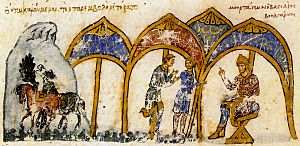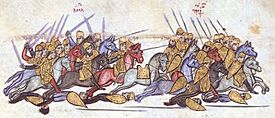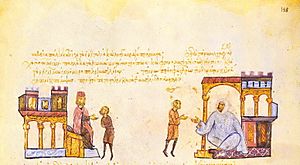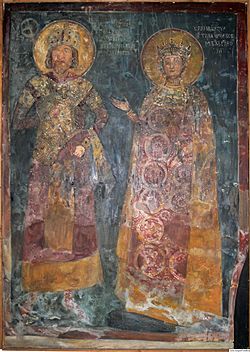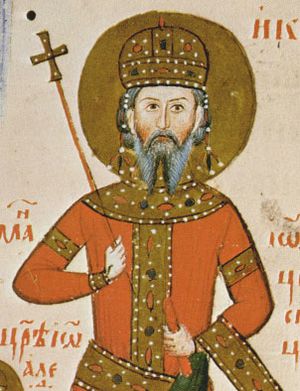Byzantine–Bulgarian wars facts for kids
Quick facts for kids Byzantine–Bulgarian wars |
|||||||||
|---|---|---|---|---|---|---|---|---|---|
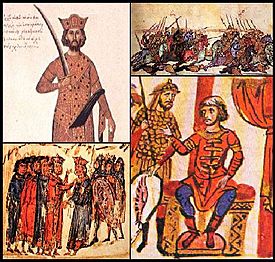 Clockwise from right: The Battle of Anchialus; Khan Omurtag; The rulers of Bulgaria and Byzantium negotiate for peace; Emperor Nikephoros II Phokas. |
|||||||||
|
|||||||||
| Belligerents | |||||||||
| First Bulgarian Empire Second Bulgarian Empire | Byzantine Empire | ||||||||
| Commanders and leaders | |||||||||
| Khans and Tsars: Asparuh Tervel Kormisosh Vinekh Telets Telerig Krum Omurtag Malamir Presian I Boris I Simeon I Peter I Boris II Samuel Gavril Rodomir Ivan Vladislav Peter II Peter III Peter IV Ivan Asen I Ivanko Kaloyan Ivan Asen II Michael Asen I Mitso Asen Constantine I Ivaylo Smilets Theodore Svetoslav George II Michael Asen III Ivan Stephen Ivan Alexander |
Emperors: Constantine IV Justinian II Philippikos Bardanes Constantine V Nikephoros I Logothetes † Michael I Rangabe Leo V the Armenian Theophilos Michael III Leo VI the Wise Alexander Leo Phokas the Elder Romanos I Nikephoros II Phokas John I Tzimiskes Basil II the Bulgar-slayer Gregory Taronites † Nikephoros Ouranos Michael IV the Paphlagonian Michael VII Doukas Isaac II Angelos Alexios III Angelos John III Doukas Vatatzes Theodore II Laskaris Michael VIII Palaiologos Andronikos II Palaiologos Michael IX Palaiologos Andronikos III Palaiologos |
||||||||
The Byzantine–Bulgarian wars were a long series of fights between the Byzantine Empire and the Bulgarians. These conflicts lasted for over 670 years, from 680 to 1355! They started when the Bulgars, who founded Bulgaria, settled in the Balkan peninsula in the 670s. The fighting grew more intense as the First Bulgarian Empire expanded after 681 AD.
Over the next century, the Byzantines and Bulgarians often fought, with wins and losses for both sides. A powerful Bulgarian ruler named Krum dealt some big defeats to the Byzantines. After Krum died in 814, his son Omurtag signed a peace treaty that lasted for thirty years. Later, Simeon I had many successful campaigns against the Byzantines from 893 to 927. His son Peter I also made a long-lasting peace. But after Peter's rule, the Bulgarian state became weaker.
In 971, the Byzantine Emperor John I Tzimiskes took over much of the weakening Bulgarian Empire. He defeated Boris II and captured Preslav, the Bulgarian capital. However, Samuel managed to make the Bulgarian state strong again, with its center around Prespa. Near the end of his rule, the Byzantines gained the upper hand. Under Emperor Basil II, they won the Battle of Kleidion and fully conquered Bulgaria in 1018.
People rebelled against Byzantine rule in 1040–1041 and again in the 1070s and 1080s, but these revolts failed. Then, in 1185, Theodore Peter and Ivan Asen started a new revolt. The Byzantine Empire was weak and had its own internal problems, so it couldn't stop the rebellion.
After the Fourth Crusade army captured Constantinople in 1204, the Bulgarian Emperor Kaloyan tried to be friends with the crusaders. But the new Latin Empire didn't want an alliance with the Bulgarians. Because of this, Kaloyan teamed up with the Nicaeans, which reduced the crusaders' power. Even though Kaloyan's nephew Boril later allied with the Latin Empire, Boril's successors sided with the Nicaeans.
After the Latin Empire fell, the Byzantines took advantage of a civil war in Bulgaria. They captured parts of Thrace. But the Bulgarian Emperor Theodore Svetoslav took these lands back. The relationship between Byzantium and Bulgaria kept changing until the Ottoman Turks captured the Bulgarian capital in 1393 and the Byzantine capital in 1453.
Contents
- Early Conflicts: Bulgaria's Beginnings
- Byzantine Attacks and Bulgarian Struggles
- Khan Krum's Powerful Rule
- Later Conflicts and Christianization
- Simeon I's Imperial Dreams
- Peter I and the Byzantine Conquest
- Bulgarian Rebellions and Civil Wars
- The Second Bulgarian Empire's Rise
- New Empires and Shifting Alliances
- Later Conflicts and the Ottoman Threat
- The End of an Era
- See also
Early Conflicts: Bulgaria's Beginnings
The Byzantines first fought the Bulgars when Khan Kubrat's youngest son, Asparuh, moved his people west. They settled in what is now southern Bessarabia.
Asparuh's Victory
Asparuh defeated the Byzantines, led by Emperor Constantine IV, in a combined land and sea attack. He successfully surrounded their camp at Ongala. The emperor became ill and had to leave his army. This caused the Byzantine soldiers to panic and lose the battle. In 681, Emperor Constantine had to officially recognize the First Bulgarian Empire in Moesia. He also had to pay the Bulgarians protection money to stop them from attacking Byzantine Thrace. Eight years later, Asparuh led another successful campaign into Byzantine Thrace.
Tervel's Support for Justinian
Tervel is first mentioned in Byzantine writings in 704. The deposed Emperor Justinian II asked Tervel for help to get his throne back. Tervel agreed to help in exchange for friendship, gifts, and Justinian's daughter in marriage. With 15,000 horsemen from Tervel, Justinian suddenly attacked Constantinople and entered the city in 705.
Justinian, now back on the throne, punished those who had replaced him. He rewarded Tervel with many gifts and the important title of kaisar (Caesar). This made Tervel second only to the emperor. He was the first foreign ruler in Byzantine history to receive such a title. Tervel also possibly gained some land in northeastern Thrace, called Zagore.
Tervel's Later Battles
Just three years later, Justinian II broke their agreement and tried to take back the land he had given away. Tervel defeated him at the Battle of Anchialus in 708. In 711, Justinian faced a big revolt in Asia Minor. He asked Tervel for help again, but Tervel only sent 3,000 soldiers. Justinian was captured and executed by the rebel emperor Philippicus. Tervel's Bulgarian allies were allowed to return home.
Tervel took advantage of the chaos in Byzantium. In 712, he raided Thrace, plundering areas close to Constantinople. Tervel likely died in 715. However, some records say he helped restore Emperor Anastasius II in 718 or 719. If so, he also signed a new treaty with Emperor Theodosius III in 716. This treaty confirmed the yearly payment from Byzantium to Bulgaria and land deals in Thrace. It also set rules for trade and political refugees. Tervel's forces also helped defend Constantinople during the second Arab siege in 717–718. The Bulgarians reportedly killed about 22,000 Arabs in that battle.
Byzantine Attacks and Bulgarian Struggles
After the death of Sevar, Bulgaria went through a difficult time with many changes in rulers. Meanwhile, the Byzantines grew stronger.
Constantine V's Campaigns
Between 756 and 775, the new Byzantine Emperor Constantine V led nine campaigns against Bulgaria. He wanted to move the Byzantine border to the Danube river. Bulgaria was almost destroyed because of frequent changes in rulers (eight Khans in twenty years) and constant political problems.
In his first campaign in 756, Constantine V won twice against the Bulgars. But in 759, the Bulgar Khan Vinekh completely defeated the Byzantine army at the Battle of the Rishki Pass. Vinekh then tried to make peace, but Bulgar nobles killed him. The new ruler, Telets, was defeated at the Battle of Anchialus in 763.
In later campaigns, neither side won much. The Byzantines couldn't get through the Balkan Mountains. Their fleet was also destroyed twice by bad storms. In 774, they defeated a smaller Bulgarian force at Berzitia. This was Constantine V's last success. After this defeat, the Bulgars took steps to find and execute Byzantine spies in Pliska. Khan Telerig tricked Constantine V into revealing his agents. Constantine V died in 775, so the Byzantines couldn't get revenge.
Constantine VI's Failed Revenge
In 791, Byzantine Emperor Constantine VI attacked Bulgaria. This was in response to Bulgarian raids in the Struma valley since 789. Kardam, the Bulgarian ruler, met the Byzantines near Adrianople in Thrace. The Byzantine army was defeated and ran away.
In 792, Constantine VI led another army against the Bulgars. He set up camp and fortified it at Marcellae. Kardam arrived with his army on July 20 and took over nearby high ground. After a standoff, Constantine VI ordered an attack. But in the Battle of Marcellae, the Byzantine forces lost formation and were defeated again. Kardam captured the emperor's tent and servants. After returning to Constantinople, Constantine VI signed a peace treaty. He agreed to pay Bulgaria a yearly tribute.
By 796, the Byzantine government didn't want to pay the tribute. Kardam demanded the payment, threatening to destroy Thrace if it wasn't paid. Constantine VI reportedly sent dung instead of gold as "fitting tribute." He also promised to lead a new army against Kardam. The emperor's army headed north again and met Kardam near Adrianople. The armies faced each other for 17 days without fighting, likely negotiating. In the end, they avoided conflict, and peace continued on the same terms as in 792.
Khan Krum's Powerful Rule
Khan Krum was a very aggressive ruler in the Balkans. In 807, he raided the Struma valley, defeating a Byzantine army and capturing a huge amount of gold. In 809, Krum surrounded and captured Serdica (Sofia). He killed the Byzantine soldiers there, even though he had promised them safe passage. This made Byzantine Emperor Nikephoros I angry. Nikephoros tried to resettle people along the border and refortify Serdica, but he failed.
Krum's Conflict with Nikephoros I
In early 811, Nikephoros I launched a huge attack on Bulgaria. He advanced to Marcellae. Krum tried to negotiate on July 11, 811, but Nikephoros wanted to keep going. His army avoided Bulgarian traps in the Balkan Mountains. They defeated a Bulgarian army of 12,000 that tried to stop them from entering Moesia. Another quickly gathered army of 50,000 was defeated outside the Bulgarian capital, Pliska. The city fell to the emperor on July 20. Nikephoros took Krum's treasures, burned the city, and attacked the people. Krum tried to negotiate again, but Nikephoros refused. The emperor showed great cruelty, ordering his army to kill the capital's population.
Nikephoros became worried about his army losing discipline and finally began to retreat towards Thrace. Meanwhile, Krum had gathered everyone he could, including women. He set traps and ambushes for the retreating Byzantine army in the mountain passes. At dawn on July 26, the Byzantines found themselves trapped in the Vărbica pass. Nikephoros was killed in the battle, along with many of his soldiers. His son Staurakios was badly wounded but was carried to safety.
Krum's Conflict with Michael I Rangabe
Staurakios had to give up his throne after a short rule (he died from his wound in 812). His brother-in-law, Michael I Rangabe, became emperor. In 812, Krum invaded Byzantine Thrace. He took Develt and scared people in nearby fortresses into fleeing towards Constantinople. From this strong position, Krum offered to return to the peace treaty of 716. The new Emperor Michael I refused, not wanting to seem weak. To pressure the emperor, Krum surrounded and captured Mesembria (Nesebar) in the fall of 812.
In February 813, the Bulgarians raided Thrace but were pushed back by the emperor's forces. Encouraged, Michael I gathered troops from across the empire and headed north, hoping for a big victory. Krum led his army south towards Adrianople and camped near Versinikia. Michael I lined up his army against the Bulgarians, but neither side attacked for two weeks. Finally, on June 22, 813, the Byzantines attacked but immediately ran away. Krum's cavalry chased them, completing Michael I's defeat. Krum then advanced on Constantinople and surrounded it by land. Michael was forced to give up his throne and become a monk. He was the third Byzantine emperor defeated by Krum in three years.
Krum's Conflict with Leo V the Armenian
The new emperor, Leo V the Armenian, offered to talk and arranged a meeting with Krum. When Krum arrived, Byzantine archers ambushed him, and he was wounded as he escaped. Furious, Krum destroyed the areas around Constantinople. He then went home, capturing Adrianople along the way. He moved its people (including the parents of the future Emperor Basil I) across the Danube river. Even though winter was coming, Krum sent 30,000 soldiers into Thrace. They captured Arkadioupolis (Lüleburgaz) and took about 50,000 captives. The treasures from Thrace made Krum and his nobles rich. They also used architectural parts to rebuild Pliska, perhaps with the help of captured Byzantine builders.
Krum spent the winter preparing for a huge attack on Constantinople. Rumors said he was gathering a massive siege army to be carried on 5,000 carts. However, he died before he could set out, on April 13, 814. His son Omurtag became the new ruler.
Omurtag's Peace Treaty
Khan Omurtag's rule began with an invasion of the Byzantine Empire. The Byzantines had offered peace, but Omurtag rejected it. The Bulgarians went as far south as modern Babaeski. But there, Emperor Leo V the Armenian defeated them, and Omurtag escaped on his fast horse. This battle was not a complete defeat for the Bulgarians.
Omurtag had reasons to make peace. There was a chance of an anti-Bulgarian alliance between the Byzantine and Frankish empires. He also needed to strengthen Bulgarian control in newly conquered lands. So, Omurtag signed a 30-year peace treaty with the Byzantines in 815. Part of this treaty is written on a surviving stone column found near Seltsi. The treaty set the border in Thrace, dealt with Slavs who stayed in Byzantium, and arranged for the exchange of prisoners of war. Both sides respected the treaty. It was renewed when the new Byzantine Emperor Michael II came to power in 820.
In 821, Thomas the Slav rebelled against the Byzantine Emperor and surrounded Constantinople. Khan Omurtag sent an army to help Michael II stop the rebellion. They attacked the rebels at the Battle of Kedouktos in late 822 or early 823.
Later Conflicts and Christianization
After the 20-year peace treaty with the Byzantine Empire ended in 836, Emperor Theophilos raided areas near the Bulgarian border. The Bulgarians fought back. Under the leadership of Isbul, they reached Adrianople. Around this time, the Bulgarians took over Philippopolis (Plovdiv) and its surrounding areas. Several old writings from this time mention Bulgarian victories and building projects in Pliska.
The war ended when Slavs near Thessalonica rebelled against the Byzantine Empire in 837. Emperor Theophilos asked for Bulgarian help to stop the rebellion. But at the same time, he secretly sent his fleet to the Danube delta. They quietly rescued some Byzantine captives that Krum and Omurtag had settled north of the Danube. In response, Isbul attacked along the Aegean coasts of Thrace and Macedonia. He captured the city of Philippi. Isbul's campaign may have led to the Bulgarians gaining control over the Slavic tribe of the Smoljani.
Boris I and Christianity
Boris I was a skilled diplomat and statesman. He was very important in converting Bulgaria to Christianity. However, he was not always successful in war. He was defeated by the Franks, Croats, Serbs, and Byzantines at different times.
Soon after becoming ruler, Boris launched a short campaign against the Byzantines in 852. We don't have many details about this war, but he might have gained some land in inland Macedonia.
Another conflict between the Byzantines and Bulgarians began in 855–856. The Byzantine Empire wanted to regain control over parts of inland Thrace and the ports around the Gulf of Burgas on the Black Sea. Byzantine forces, led by Emperor Michael III and Caesar Bardas, won this conflict. They reconquered several cities, including Philippopolis, Develtus, Anchialus, and Mesembria. They also took back the border region called Zagora. During this time, the Bulgarians were busy fighting a war with the Franks and the Croatians.
In 863, Boris decided to become Christian. He sought help from the Franks for this. The Byzantines didn't want a close neighbor like Bulgaria to be under Frankish religious influence. Byzantium had recently won a big victory against the Arabs, so they had many soldiers available. They sent a fleet into the Black Sea and an army to invade Bulgaria. Most of Boris's army was far away, fighting in Great Moravia. So, he had no choice but to surrender immediately. He ended his alliance with the Franks, allowed Greek priests into Bulgaria, and was baptized. The Byzantine Emperor Michael III was his sponsor, and Boris took the additional name Michael. As a reward for changing their religion, the Bulgarians were allowed to get back the disputed region of Zagora.
Simeon I's Imperial Dreams
When Simeon I became ruler in 893, the long peace with the Byzantine Empire was about to end. A conflict started because Byzantine Emperor Leo VI the Wise moved the market for Bulgarian goods from Constantinople to Thessaloniki. There, Bulgarian merchants had to pay very high taxes. Simeon had to act. In the autumn of 894, he invaded the Byzantine Empire from the north. He met little resistance because most Byzantine forces were in eastern Anatolia fighting Arab invasions.
Leo was surprised by the Bulgarian attack. He sent an army from the capital to stop Simeon, but his troops were defeated in Macedonia. The war ended in 896 with a great Bulgarian victory near Bulgarophygon in Eastern Thrace. The market was moved back to Constantinople, and the Byzantine Emperor had to pay Bulgaria a yearly tribute. Also, with help from the Pechenegs, Simeon successfully fought off an invasion by the Magyars, who were working with the Byzantines.
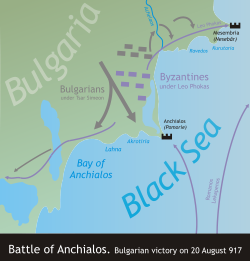
After Leo VI died in 912, his infant son Constantine VII became emperor. Leo's brother Alexander guided the young emperor. Simeon wanted the imperial title for himself. He tried to make Bulgaria the most powerful state in the region, perhaps creating a new Bulgarian–Byzantine empire. Alexander died in 913, leaving the capital in chaos. A council led by Patriarch Nicholas Mystikos ruled the empire. This gave Simeon a great chance to attack the Byzantine capital. He attacked in full force in late July or August 913, reaching Constantinople without much resistance.
After long talks, the Byzantines agreed to pay their overdue tribute. They also promised that Constantine VII would marry one of Simeon's daughters. Most importantly, Patriarch Nicholas officially recognized Simeon as Emperor (tzar) of the Bulgarians. From then on, Simeon called himself "Emperor of the Bulgarians and the Romans."
Soon after Simeon's visit, Constantine's mother Zoe returned to the palace. She quickly removed the regents and took power in February 914. She rejected Nicholas's recognition of Simeon's title and the planned marriage. In response, Simeon invaded Thrace in the summer of 914 and captured Adrianople.
In 917, a very strong Byzantine army, led by Leo Phokas, invaded Bulgaria. The Byzantine navy, commanded by Romanos Lekapenos, sailed to Bulgarian Black Sea ports. Phokas's forces stopped to rest near the Acheloos river, not far from Anchialos (Pomorie). Simeon learned of the invasion and quickly attacked the Byzantines from nearby hills while they were resting. In the Battle of Achelous on August 20, 917, the Bulgarians completely defeated the Byzantines. Many Byzantine commanders were killed, though Phokas escaped. After this victory, Simeon gained the support of Pecheneg leaders and launched a major attack against Byzantine lands in Europe. The Bulgarians chased the remaining Byzantine army towards Constantinople. They met Byzantine forces under Leo Phokas near Constantinople at Katasyrtai.
Simeon also pursued an aggressive policy against the Medieval Serbian regions that supported Byzantium. Bulgarian troops invaded Serbia, removing local rulers. Meanwhile, the admiral Romanos Lekapenos replaced Zoe as regent for young Constantine VII in 919. He became co-emperor in December 920, taking control of the empire. Simeon could no longer gain the Byzantine throne through talks, so he had to go to war again. Between 920 and 922, Bulgaria increased its pressure on Byzantium. They campaigned in the west, reaching the Isthmus of Corinth. In the east, they reached and crossed the Dardanelles to surround the town of Lampsacus. Simeon's forces appeared before Constantinople in 921, demanding Romanos be removed and capturing Adrianople. In 922, they won at Pigae, burning much of the Golden Horn and seizing Bizye.
Desperate to conquer Constantinople, Simeon planned a big campaign in 924. He sent messengers to the Shia Fatimid ruler Ubayd Allah al-Mahdi Billah, who had a powerful navy. Simeon needed this navy. Ubayd Allah agreed and sent his own representatives back with the Bulgarians to arrange the alliance. However, the Byzantines captured the messengers in Calabria. Romanos offered peace to the Fatimids, along with generous gifts. This ruined the Fatimids' new alliance with Bulgaria.
In 924, Simeon sent an army to remove his former ally, Zaharije Pribisavljević. He succeeded, and Zaharije fled to Croatia. In the summer of the same year, Simeon arrived at Constantinople. He demanded to see the patriarch and the emperor. He talked with Romanos on the Golden Horn on September 9, 924. They arranged a truce. Byzantium would pay Bulgaria a yearly tax, but Bulgaria would give back some cities on the Black Sea coast.
In 926, Simeon's troops invaded Croatia, which was a Byzantine ally. But they were severely defeated by the army of King Tomislav in the Battle of the Bosnian Highlands. A peace was arranged between Simeon and Tomislav by a papal representative. Even though the army he sent to Croatia was destroyed, Simeon still had enough soldiers to plan new attacks against the Byzantines.
After 14 years of war, Simeon was ultimately frustrated in his plans to take the Byzantine throne. In 927, while planning another attack on the Byzantines, he died of a heart attack in his palace in Preslav on May 27.
Peter I and the Byzantine Conquest
Soon after becoming ruler, Simeon's son Peter I restarted the war and raided Byzantine Thrace. After this show of strength, Peter sent a diplomatic group to Constantinople to ask for peace. Peace was achieved, and the borders were set back to how they were in 897 and 904. Simeon's conquests in Thrace were returned to the Byzantine Empire. In return, Byzantium recognized Bulgarian control over inland Macedonia. Peter also gained a Byzantine bride, Maria Lecapena, who was the granddaughter of Romanus I. He also received a yearly payment and recognition of his title of tsar and the independent status of the Bulgarian church. This peace lasted until 966.
After Peter's empress died in the mid-960s, the Byzantine Emperor Nikephoros II Phokas refused to pay the yearly tribute to Bulgaria in 966. He complained about Bulgaria's alliance with the Magyars. Nikephoros II then showed his military strength at the Bulgarian border. Instead of directly attacking Bulgaria, Nikephoros II sent a messenger to the Kievan prince Sviatoslav Igorevich. He arranged for Sviatoslav to attack Bulgaria from the north. Sviatoslav quickly launched a campaign with a large force and defeated the Bulgarians on the Danube. He captured about 80 Bulgarian fortresses in 968.
Emperor Nikephoros II was surprised by Sviatoslav's success and worried about his true intentions. He quickly made peace with Bulgaria. He arranged for his young wards, the future emperors Basil II and Constantine VIII, to marry two Bulgarian princesses. Two of Peter's sons were sent to Constantinople as negotiators and honorary guests. Meanwhile, Peter managed to make the Kievan forces retreat by encouraging Bulgaria's allies, the Pechenegs, to attack Kiev itself.
Sviatoslav's Invasion and Byzantine Takeover
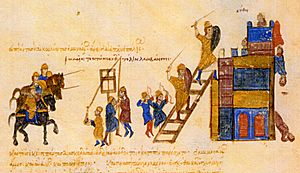
In 968, Boris II, who would become the next emperor of Bulgaria, went to Constantinople again. He negotiated a peace deal with Emperor Nikephoros II Phokas and served as an honorary hostage. This agreement was meant to end the conflict between Bulgaria and Byzantium. They would now work together against Prince Sviatoslav I of Kiev, whom the Byzantine emperor had used against the Bulgarians.
In 969, a new Kievan invasion defeated the Bulgarians again. Peter I gave up his throne to become a monk. Boris II was allowed to return to Bulgaria and take his father's throne. However, Boris II couldn't stop the Kievan advance. He was forced to accept Sviatoslav of Kiev as his ally, turning against the Byzantines. A Kievan campaign into Byzantine Thrace was defeated at Arcadiopolis in 970. The new Byzantine Emperor John I Tzimiskes advanced north.
Sviatoslav failed to defend the Balkan passes, allowing the Byzantines to enter Moesia. They surrounded the Bulgarian capital, Preslav. Bulgarians and Russians defended the city together, but the Byzantines managed to set fire to the wooden buildings and roofs with missiles. They captured the fortress. Boris II became a prisoner of John I Tzimiskes. John continued to pursue the Russians, surrounding Sviatoslav in Drăstăr (Silistra). John claimed to be Boris's ally and protector, treating the Bulgarian ruler with respect.
After Sviatoslav made peace and left for Kiev, the Byzantine emperor returned to Constantinople in triumph. John did not liberate Bulgaria as he had claimed. Instead, he brought Boris II and his family, along with the Bulgarian imperial treasury, to Constantinople in 971. In a public ceremony, Boris II was stripped of his imperial symbols. He was given the Byzantine court title of magistros as compensation. The Bulgarian lands in Thrace and lower Moesia now became part of the Byzantine Empire and were ruled by Byzantine governors.
Tsar Samuel and Basil II

Even though the ceremony in 971 was meant to end the Bulgarian empire, the Byzantines couldn't control the western parts of Bulgaria. These areas remained under the rule of local governors, especially a noble family called the Cometopuli. There were four brothers: David, Moses, Aron, and Samuel. The Byzantines saw this as a "revolt." But the Cometopuli likely saw themselves as ruling for the captive Boris II.
As they began to raid nearby Byzantine territories, the Byzantine government tried a trick. They allowed Boris II and his brother Roman to escape from their honorary captivity. They hoped this would cause a split among the Cometopuli and other Bulgarian leaders. As the brothers entered Bulgarian-controlled territory in 977, Boris II got off his horse and went ahead. Because of his clothes, a deaf and mute border guard mistook him for a Byzantine noble and shot him. Roman managed to identify himself and was accepted as emperor. However, since he was a eunuch, he couldn't have heirs, so he couldn't take the throne. Instead, Samuel, the youngest of the Cometopuli brothers, continued to resist the Byzantines.
Although the Byzantines eventually captured all of Bulgaria, Samuel resisted Emperor Basil II for decades. Samuel is the only person to ever defeat Basil II in battle. In 986, Samuel drove Basil II's army from the field at the Battle of the Gates of Trajan. The emperor barely survived and soon turned his attention to new conquests in the east. Samuel's victory led Pope Gregory V to recognize him as Tsar, and he was crowned in Rome in 997.
In 1002, a full-scale war broke out. By this time, Basil's army was stronger. The emperor was determined to conquer Bulgaria once and for all. He used much of his imperial army, which was experienced from fighting Arabs in the east. Samuel was forced to retreat into the heart of his country. Still, by harassing the powerful Byzantine army, Samuel hoped to force Basil to make peace. For twelve years, Samuel's tactics kept Bulgaria independent. He even kept Basil away from the main Bulgarian cities, including the capital of Ohrid.
However, on July 29, 1014, at Kleidion (present-day Blagoevgrad Province), Basil II managed to trap the main Bulgarian army and force a battle while Samuel was away. Basil won a crushing victory. According to later stories, he blinded 14,000 prisoners, leaving one man in every hundred with one eye to lead his comrades home. The legend says that the sight of this horror was too much for Samuel. He blamed himself for the defeat and died less than three months later, on October 6. This story is a later invention, which led to Basil II being known as the 'Bulgar-slayer' from the 12th century onwards.
Ivan Vladislav's Resistance
The Bulgarian Emperor Ivan Vladislav rebuilt the defenses of Bitola in 1015. He survived an assassination plot by Byzantine agents. Although the Byzantines sacked Ohrid, they failed to take Pernik. They also heard that Ivan Vladislav was trying to get the Pechenegs to help him, following the example of earlier Bulgarian rulers.
While Byzantine armies went deep into Bulgaria in 1016, Ivan Vladislav gathered his forces. He began a siege of Dyrrachium (Durazzo) in the winter of 1018. During a battle in front of the city, Ivan Vladislav was killed. After his death, much of the Bulgarian nobility and court, including his widow Maria and his sons, surrendered to the advancing Basil II. They were guaranteed their lives, status, and property.
Bulgarian Rebellions and Civil Wars
The newly declared Bulgarian emperor Peter II later led a large revolt against the Byzantines. Peter II Delyan took Niš and Skopje. He first worked with, then removed, another potential leader named Tihomir, who had led a rebellion in the Durazzo region. After this, Peter II marched on Thessalonica, where the Byzantine Emperor Michael IV was staying. Michael fled, leaving his treasury to a man named Michael Ivac. This Ivac likely gave most of the treasury to Peter outside the city. Thessalonica remained Byzantine, but Macedonia, Durazzo, and parts of northern Greece were taken by Peter II's forces. This inspired more Slavic revolts against Byzantine rule in Epirus and Albania.
Peter II Delyan's successes ended when his cousin Alusian interfered. Alusian's father, Ivan Vladislav, had murdered Peter's father, Gavril Radomir, in 1015. Alusian joined Peter II's forces, pretending to be a deserter from the Byzantine court where he had been disgraced. Peter II welcomed him and gave him an army to attack Thessalonica. However, the Byzantines lifted the siege, and the army was defeated. Alusian barely escaped and returned to Ostrovo.
One night in 1041, during dinner, Alusian attacked Peter II and blinded him. Since Alusian was related to Samuel, his troops quickly declared him emperor instead of Peter II. But Alusian secretly planned to switch sides to the Byzantines. As the Bulgarian and Byzantine troops prepared for battle, Alusian deserted to the enemy. He went to Constantinople, where his possessions and lands were returned to him. He was also rewarded with the high court title of magistros.
Meanwhile, even though he was blind, Peter II Delyan took command of the Bulgarian forces again. But the Byzantine Emperor Michael IV decided to take advantage of the situation and advanced against them. In a battle near Ostrovo, the Byzantines defeated the Bulgarian troops. Peter II Delyan was captured and taken to Constantinople, where he might have been executed. Some Norse stories say that the future Norwegian King Harald Hardråda killed Peter II in battle while serving in the Varangian Guard. Peter II Delyan likely died in 1041.
Peter III's Revolt
The troops of the newly crowned Peter III took Niš and Ohrid. But they suffered a terrible defeat in front of Kastoria. The Byzantine counter-attack took Skopje with the help of Georgi Voiteh. Voiteh first betrayed Peter III, then tried to betray the Byzantines, but failed. In another battle, Peter III was captured by the Byzantines and sent, along with Georgi Voiteh, as prisoners to Constantinople. Voiteh died on the way, while Peter III remained in prison first in Constantinople and then in Antioch.
The Second Bulgarian Empire's Rise
In 1185, Theodore (Peter IV) and his younger brother Ivan Asen went to the Byzantine Emperor Isaac II Angelos at Kypsela. They asked for a pronoia (a grant of land or income), but their request was rudely refused. Ivan Asen was even slapped during an argument. The insulted brothers returned home to Moesia. They took advantage of the unhappiness caused by heavy taxes from the Byzantine emperor. These taxes were to pay for his wars and his marriage. The brothers started a revolt against Byzantine rule.
The rebellion didn't immediately capture Bulgaria's old capital, Preslav. But they established a new capital city at Tărnovo, which was likely the center of the revolt. In 1186, the rebels were defeated. However, Isaac II Angelos failed to use his victory and returned to Constantinople. With help from the Cuman people north of the Danube, Peter IV and Ivan Asen regained their strength. They raided into Thrace. When Isaac II Angelos entered Moesia again in 1187, he failed to capture Tărnovo or Loveč. He signed a treaty that basically recognized the Second Bulgarian Empire. But neither side truly intended to keep the peace. When the Third Crusade led by Frederick I was moving towards Constantinople, representatives of Peter IV and Ivan Asen offered him military help against Isaac II Angelos at Niš and again at Adrianople.
Isaac II Angelos' Failed Attacks
After the Third Crusade passed, Isaac II Angelos decided to deal with the Bulgarians once and for all. His large expedition reached Tărnovo and surrounded it for a long time. By this time, Peter IV had crowned Ivan Asen I as co-emperor in 1189. Peter then retired to Preslav without giving up his title. Ivan Asen I was in charge of defending Tărnovo. He tricked the Byzantine emperor into a quick retreat by spreading rumors that a large Cuman army was coming to help the besieged city. The retreating Byzantine army was ambushed by Ivan Asen I in the Balkan passes, and Isaac II barely escaped with his life in 1190.
Success now clearly favored the Bulgarians. They captured Sredec (Sofia) and Niš in 1191, Belgrade in 1195, and Melnik and Prosek in 1196. Raiding parties reached as far south as Serres. When the Bulgarian emperor Ivan Asen I was murdered, his successor Kaloyan continued an aggressive policy against the Byzantine Empire. He made an alliance with Ivanko, Ivan Asen I's murderer. Ivanko had joined Byzantine service in 1196 and became governor of Philippopolis (Plovdiv). Another ally of Kaloyan was Dobromir Hriz (Chrysos), who ruled the area of Strumica. This alliance quickly broke apart as the Byzantines defeated both Ivanko and Dobromir Hriz. Nevertheless, Kaloyan conquered Konstanteia (Simeonovgrad) in Thrace and Varna from the Byzantine Empire in 1201, and most of Slavic Macedonia in 1202.
New Empires and Shifting Alliances
The war between the Bulgarians and the Byzantines paused in 1204. This happened when Catholic forces of the Fourth Crusade captured and sacked Constantinople. They created the Latin Empire, choosing Baldwin I of Flanders as emperor. Kaloyan had offered the crusaders an alliance against the Byzantine Empire, but they refused. The Latin Empire wanted to conquer all the lands of the former Byzantine Empire, including the territories ruled by Kaloyan. The coming conflict was started by the Byzantine nobles in Thrace. They rebelled against Latin rule in 1205 and asked Kaloyan for help, offering to submit to him.
Latin Wars and New Alliances
From 1204 to 1261, Bulgarians and Byzantines mostly fought the Latins. But they still held grudges against each other. At first, the Bulgarians had good success against the Latins. However, the Byzantine nobles then began to rebel or plot against Kaloyan's rule. Kaloyan also changed his approach and became ruthless towards his former allies. He took the nickname Rōmaioktonos ("slayer of Romans"), as a counter to Basil II's Boulgaroktonos ("slayer of Bulgarians").
But generally, relations between the Bulgarians and Nicaea, the main Byzantine successor state, remained strong. Bulgaria's new pro-Nicaean alignment reached its peak with the marriage between Ivan Asen II's daughter Elena and the future Theodore II Laskaris. He was the son of Emperor John III Doukas Vatatzes of Nicaea. This family union was celebrated in 1235. It also happened at the same time as the Bulgarian patriarchate was restored with the agreement of the eastern patriarchs. There was also a siege of Constantinople by the combined forces of John III and Ivan Asen II. Later, the Bulgarians decided not to help either the Latin Empire or the Nicaeans. Both were too busy fighting each other to attack Bulgaria. During the 1240s and 1250s, Emperors John III Doukas Vatatzes and his son Theodore II Laskaris led successful campaigns against the Bulgarian Tsardom.
Bulgarian Civil Wars and Byzantine Interference
Soon after the Byzantine Empire was restored under Michael VIII Palaiologos, he got involved in a civil war in Bulgaria. Michael supported Ivan Asen and sent several Byzantine armies to put him on the throne. Ivailo, the current Bulgarian ruler, defeated several of these attempts. But he was trapped for three months in Drăstăr (Silistra) by the Mongol allies of the Byzantine emperor. Meanwhile, a Byzantine force surrounded the Bulgarian capital. After hearing a rumor that Ivailo had died in battle, the local nobles surrendered. They accepted Ivan Asen III as emperor in 1279.
Shortly after this, in 1279, Ivailo suddenly appeared before Tărnovo with an army. But he failed to take the well-fortified city. Nevertheless, he defeated a larger Byzantine relief force near Varna and another in the Balkan passes. Desperate for help, Ivan Asen III fled Tărnovo in 1280. His brother-in-law, George Terter I, seized the throne. He united the divided nobles and slowly took away support for Ivailo.
Later Conflicts and the Ottoman Threat
During the 13th century, both the Byzantine and Bulgarian empires began to weaken. They often allied with each other to fight off powerful enemies like the Golden Horde and the Turks. However, in 1301, the new, aggressive Bulgarian emperor Theodore Svetoslav had several bloody fights with the Byzantines. He first defeated the former emperor Michael Asen II, who unsuccessfully tried to enter Bulgaria with a Byzantine army around 1302.
Because of his success, Theodore felt strong enough to attack by 1303. He captured several fortresses in northeastern Thrace, including Mesembria (Nesebăr), Ankhialos (Pomorie), Sozopolis (Sozopol), and Agathopolis (Ahtopol) the next year. The Byzantine counter-attack failed at the battle on the river Skafida near Sozopolis, where the co-emperor Michael IX Palaiologos was forced to flee. Nevertheless, the war continued, with Michael IX and Theodore Svetoslav taking turns raiding each other's lands.
In 1305, Theodore's uncle Aldimir seemed to have made a deal with the Byzantines. Theodore Svetoslav then took over Aldimir's lands. In 1306, Svetoslav gained the help of the rebellious Alans, who had previously worked as mercenaries for the Byzantines. He settled them in Bulgaria. He also tried, but failed, to get the mercenaries of the Catalan Company, who had also rebelled against their Byzantine employers. The war ended with a peace treaty in 1307. It was strengthened by a marriage between the widowed Theodore Svetoslav and Theodora Palaiologina, a daughter of Michael IX.
George Terter II's War
George Terter II became the Bulgarian ruler after his father died in 1322. He became actively involved in the civil war in the Byzantine Empire. The throne was being fought over by Andronikos II Palaiologos and his grandson Andronikos III Palaiologos. Taking advantage of the situation, George invaded Byzantine Thrace. He met little resistance and conquered the major city of Philippopolis (Plovdiv) and part of the surrounding area in 1322 or 1323. A Bulgarian army was stationed there under a general named Ivan the Russian. A court writer praised George Terter II as a "possessor of the Bulgarian and the Greek sceptre." A new campaign later that year captured several fortresses around Adrianople. But the Bulgarians were finally defeated by Andronikos III. The Byzantine emperor was preparing to invade Bulgaria when he heard that George Terter II had died, seemingly of natural causes.
Michael Asen III's Wars
The death of George Terter II led to a short period of confusion. The Byzantine Emperor Andronikos III Palaiologos took advantage of this. The Byzantines overran northeastern Thrace and captured several important cities. At the same time, a Byzantine-supported claimant, Vojsil, brother of the former Bulgarian emperor Smilec, established himself in Krăn. He took control of the valley between the Balkan mountains and Sredna Gora. At this point, the newly elected Bulgarian emperor Michael Asen III marched south to fight Andronikos III. Another Byzantine army was surrounding Philippopolis (Plovdiv).
Although Michael Asen III managed to force Andronikos III to retreat, the Byzantines captured Philippopolis while the Bulgarians were changing their soldiers. Despite this loss, Michael Asen III drove out Vojsil and regained control over northern and northeastern Thrace in 1324. The existing situation was confirmed by a peace treaty with the Byzantine Empire. It was strengthened by Michael Asen III's marriage to Theodora Palaiologina, the sister of Andronikos III Palaiologos. She had previously been married to Theodore Svetoslav of Bulgaria.
Byzantine Civil War and Bulgarian Involvement
In 1327, Michael Asen III got involved in the renewed civil war in the Byzantine Empire. He sided with his brother-in-law Andronikos III. His grandfather and rival, Andronikos II, got support from the Serbian king Stephen Dečanski. Andronikos III and Michael Asen III met and formed an alliance against Serbia.
However, Michael Asen III also started talking with Andronikos II. He offered military support in exchange for money and border lands. Michael Asen III marched to the border with his army. He sent a group of soldiers to supposedly help Andronikos II, but they actually planned to capture the Emperor. Warned by his grandson, Andronikos II wisely kept the Bulgarian soldiers away from the capital and himself. Giving up on his trick, Michael Asen III tried to take the lands by force. But he retreated when Andronikos III advanced. Another standoff in front of Adrianople in 1328 ended without a battle. The peace treaty was renewed, and Michael Asen III returned to his country, but not before getting a large payment.
Ivan Alexander's Defense
In the early 1340s, relations with the Byzantine Empire temporarily worsened. Ivan Alexander demanded that his cousin Shishman, one of Michael Asen III's sons, be handed over. He threatened the Byzantine government with war. However, his show of force backfired. The Byzantines called his bluff and sent the fleet of their ally, the Turkish emir of Smyrna, Umur Beg, against him. Landing in the Danube Delta, the Turks plundered the countryside and attacked Bulgarian cities nearby. Ivan Alexander was forced to act. He invaded the Byzantine Empire again at the end of 1341, claiming that the people of Adrianople had called him. There, his troops were defeated twice by Turkish allies of the Byzantines.
From 1341 to 1347, the Byzantine Empire was in a second long civil war. It was between the regency (a group ruling for the young Emperor John V Palaiologos) and his guardian John VI Kantakouzenos. The neighbors of the Byzantines took advantage of the civil war. Stefan Dušan sided with John VI Kantakouzenos, while Ivan Alexander supported John V Palaiologos and his regency. Even though the two Balkan rulers chose opposite sides in the Byzantine civil war, they kept their alliance with each other. As payment for Ivan Alexander's support, the regency for John V Palaiologos gave him the city of Philippopolis (Plovdiv) and nine important fortresses in the Rhodope Mountains in 1344.
Another Byzantine civil war broke out in Thrace in 1352. It was between Matthew Cantacuzenus and John V, who was growing up and wanted more power. To calm him down and move him away from the capital, the emperor gave John V some land in western Byzantine Thrace and the Rhodopes in late 1351 or 1352. His son, Matthew, who ruled that territory, was moved and given new land to the east, centered in Adrianople. The two princes soon argued over borders, and Matthew refused to recognize John V as the heir to the throne. Soon, war broke out between them.
After hiring many Turkish mercenaries and promising support from the Thessalonians (who were long-time enemies of Cantacuzenus), John V marched against Matthew's territory. One after another, Matthew's towns, including Adrianople, quickly surrendered to the young Palaeologian emperor. Expecting a strong counter-attack, John V sought and was promised help from both Serbia and Bulgaria. Meanwhile, Emperor John Cantacuzenus hired more Ottoman Turks. He then retook all the cities that had surrendered to John V. John V retreated west, seeking Serbian help. Stefan Dušan sent him four thousand horsemen. However, Orhan, the Ottoman bey, gave Cantacuzenus ten thousand. The Ottoman cavalry met the Serbs and possibly a Bulgarian force in an open field battle near Demotika in October 1352. The more numerous Ottomans crushed the Serbs and Bulgarians in the first major battle in Europe between Ottomans and Europeans.
The End of an Era
In 1396, Bulgaria fell to the Ottoman Turks. In 1453, Constantinople was captured. Since both empires became part of the Ottoman Empire, this marked the end of the long series of Byzantine-Bulgarian Wars.
See also
- Byzantine army
- Medieval Bulgarian army
 In Spanish: Guerras búlgaro-bizantinas para niños
In Spanish: Guerras búlgaro-bizantinas para niños




